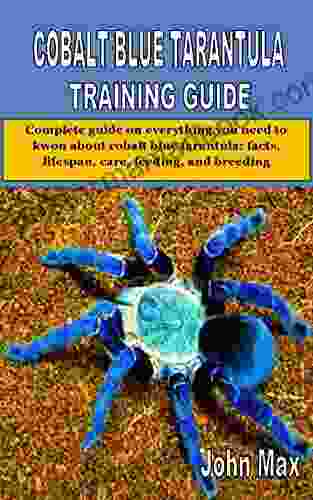Cobalt Blue Tarantula Training Guide: A Comprehensive Look at Keeping and Caring for This Stunning Tarantula Species

Cobalt Blue Tarantulas, scientifically known as Cyriopagopus lividus, are a captivating tarantula species known for their mesmerizing blue coloration and generally docile temperament. Their vibrant blue hue, which can range from a deep sapphire to a brilliant electric blue, makes them a highly sought-after species among tarantula enthusiasts.
4 out of 5
| Language | : | English |
| File size | : | 1136 KB |
| Text-to-Speech | : | Enabled |
| Enhanced typesetting | : | Enabled |
| Print length | : | 10 pages |
| Lending | : | Enabled |
| Screen Reader | : | Supported |
This training guide aims to provide a comprehensive overview of the care and training of Cobalt Blue Tarantulas. We will cover aspects such as their habitat, diet, behavior, and specific training techniques to help you create a thriving environment for your tarantula and foster a mutually rewarding bond.
Habitat
Cobalt Blue Tarantulas are native to the rainforests of Myanmar and Thailand, where they inhabit burrows or crevices in trees or among rocks. When kept in captivity, they require a habitat that mimics their natural environment as closely as possible.
* Enclosure: Choose a terrarium or enclosure that is at least 12 inches long, 12 inches wide, and 8 inches high. The enclosure should have a secure lid and ventilation holes to ensure proper airflow. * Substrate: Use a substrate that allows moisture retention and burrowing, such as coconut fiber, vermiculite, or a combination of both. The substrate should be deep enough to allow your tarantula to burrow if desired. * Shelter: Provide a hideaway for your tarantula to retreat to, such as a piece of cork bark, a clay pot, or a commercial tarantula hide. The shelter should be large enough for your tarantula to fit comfortably inside.
Diet
Cobalt Blue Tarantulas are opportunistic carnivores, feeding primarily on insects and small invertebrates.
* Feeder Insects: Offer your tarantula a variety of feeder insects, such as crickets, dubia roaches, mealworms, and waxworms. The size of the feeder insects should be appropriate for the size of your tarantula. * Feeding Frequency: Feed adult tarantulas once or twice a week. Juveniles and slings (baby tarantulas) may require more frequent feeding.
Behavior
Cobalt Blue Tarantulas are generally docile and do not pose a threat to humans. However, like all tarantulas, they can bite if they feel threatened or provoked.
* Handling: Handle your tarantula with care, using slow and gentle movements. Avoid handling your tarantula too frequently, as this can stress them out. * Aggression: If your tarantula feels threatened, it may raise its front legs in a defensive posture or release urticating hairs from its abdomen. Respect your tarantula's space and avoid handling it if it is displaying aggressive behavior.
Training
Training a Cobalt Blue Tarantula can help you build a stronger bond with your pet and create a more enriching environment for them.
* Target Training: Using a target stick or laser pointer, guide your tarantula to move towards a specific target by providing a food reward when they reach it. This can help with enclosure cleaning and facilitate handling. * Clicker Training: Associate a clicker sound with a positive experience, such as a food reward. Once your tarantula associates the clicker with something positive, you can use it to reinforce desired behaviors. * Obstacle Course: Create a simple obstacle course using items such as cardboard, branches, and small platforms. Encourage your tarantula to navigate the obstacle course by providing treats at each successful completion.
Health and Maintenance
Regular care and maintenance are essential for the well-being of your Cobalt Blue Tarantula.
* Humidity: Cobalt Blue Tarantulas require a humidity level of 70-80%. Maintain humidity by misting the enclosure regularly and providing a water dish with adequate surface area for evaporation. * Temperature: The ideal temperature range for Cobalt Blue Tarantulas is 75-85°F (24-29°C). Use a heat mat or ceramic heat emitter to maintain the desired temperature gradient within the enclosure. * Molting: Tarantulas shed their exoskeletons (molt) as they grow. During this process, they become more vulnerable and should be handled with extra care. Provide a shallow water dish during molting to prevent dehydration.
Cobalt Blue Tarantulas are fascinating and beautiful tarantula species that can make rewarding pets for experienced keepers. By following the care and training guidelines outlined in this guide, you can create a thriving environment for your tarantula and establish a strong bond with this captivating creature. Remember to prioritize their well-being, respect their space, and enjoy the unique experience of keeping a Cobalt Blue Tarantula as a companion.
4 out of 5
| Language | : | English |
| File size | : | 1136 KB |
| Text-to-Speech | : | Enabled |
| Enhanced typesetting | : | Enabled |
| Print length | : | 10 pages |
| Lending | : | Enabled |
| Screen Reader | : | Supported |
Do you want to contribute by writing guest posts on this blog?
Please contact us and send us a resume of previous articles that you have written.
 Top Book
Top Book Novel
Novel Fiction
Fiction Nonfiction
Nonfiction Literature
Literature Paperback
Paperback Hardcover
Hardcover E-book
E-book Audiobook
Audiobook Bestseller
Bestseller Classic
Classic Mystery
Mystery Thriller
Thriller Romance
Romance Fantasy
Fantasy Science Fiction
Science Fiction Biography
Biography Memoir
Memoir Autobiography
Autobiography Poetry
Poetry Drama
Drama Historical Fiction
Historical Fiction Self-help
Self-help Young Adult
Young Adult Childrens Books
Childrens Books Graphic Novel
Graphic Novel Anthology
Anthology Series
Series Encyclopedia
Encyclopedia Reference
Reference Guidebook
Guidebook Textbook
Textbook Workbook
Workbook Journal
Journal Diary
Diary Manuscript
Manuscript Folio
Folio Pulp Fiction
Pulp Fiction Short Stories
Short Stories Fairy Tales
Fairy Tales Fables
Fables Mythology
Mythology Philosophy
Philosophy Religion
Religion Spirituality
Spirituality Essays
Essays Critique
Critique Commentary
Commentary Glossary
Glossary Bibliography
Bibliography Index
Index Table of Contents
Table of Contents Preface
Preface Introduction
Introduction Foreword
Foreword Afterword
Afterword Appendices
Appendices Annotations
Annotations Footnotes
Footnotes Epilogue
Epilogue Prologue
Prologue Anabel Bright
Anabel Bright Thema Azize Serwa
Thema Azize Serwa Tyler Kent White
Tyler Kent White Amy Wright
Amy Wright Liz Williams
Liz Williams Jennifer Lee
Jennifer Lee Robert Estella
Robert Estella Richard Dobbs
Richard Dobbs Yossy Arefi
Yossy Arefi Ellie Crowe
Ellie Crowe John Carlin
John Carlin Heather Osborne
Heather Osborne Martha Beck
Martha Beck Howard Pyle
Howard Pyle Bruce Bond
Bruce Bond Richard Hougham
Richard Hougham David Moore
David Moore Michelle Anderson
Michelle Anderson 1st Edition Kindle Edition
1st Edition Kindle Edition Jason Gregory
Jason Gregory
Light bulbAdvertise smarter! Our strategic ad space ensures maximum exposure. Reserve your spot today!

 Scott Parker"An Heroi-Comical Poem In Five Cantos": A Masterpiece of Satirical Verse by...
Scott Parker"An Heroi-Comical Poem In Five Cantos": A Masterpiece of Satirical Verse by... Orson Scott CardFollow ·5.2k
Orson Scott CardFollow ·5.2k Lord ByronFollow ·7k
Lord ByronFollow ·7k Randy HayesFollow ·14.7k
Randy HayesFollow ·14.7k Scott ParkerFollow ·9.3k
Scott ParkerFollow ·9.3k Darnell MitchellFollow ·5.5k
Darnell MitchellFollow ·5.5k Floyd PowellFollow ·9.7k
Floyd PowellFollow ·9.7k Evan SimmonsFollow ·11.3k
Evan SimmonsFollow ·11.3k Dustin RichardsonFollow ·6.9k
Dustin RichardsonFollow ·6.9k

 Patrick Hayes
Patrick HayesDeath on Stage: Euphemia Martins Mystery 16
Synopsis In the...

 Benji Powell
Benji Powell1001 Best Baking Recipes Of All Time
Baking is a fun and...

 Terry Bell
Terry BellDestined War of the Covens: A Supernatural Saga of Power,...
Welcome to the...

 Mark Twain
Mark TwainBitcoin For Mere Mortals: A Comprehensive Guide for...
Bitcoin is a...

 Dennis Hayes
Dennis HayesThe Best Budget Gaming PC 2024: Build the Ultimate Gaming...
Are you looking to build the best budget...
4 out of 5
| Language | : | English |
| File size | : | 1136 KB |
| Text-to-Speech | : | Enabled |
| Enhanced typesetting | : | Enabled |
| Print length | : | 10 pages |
| Lending | : | Enabled |
| Screen Reader | : | Supported |












